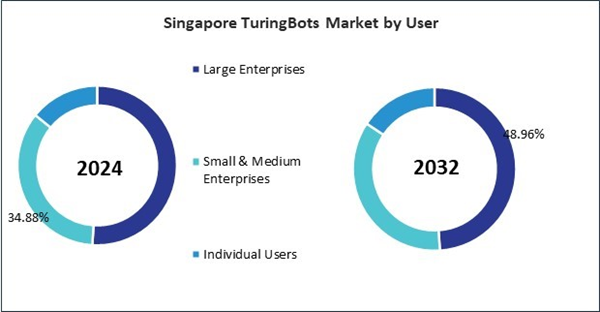The China market dominated the Asia Pacific TuringBots Market by country in 2024, and is expected to continue to be a dominant market till 2032; thereby, achieving a market value of $1.43 billion by 2032. The Japan market is registering a CAGR of 26.5% during 2025-2032. Additionally, the India market is expected to showcase a CAGR of 28% during 2025-2032.
The TuringBots market is undergoing a significant transformation as artificial intelligence continues to embed itself deeper into the core of software development processes. One of the most prominent trends is the substantial enhancement of developer productivity and operational efficiency. TuringBots, or AI-powered autonomous agents, are now capable of assisting developers throughout the entire software development lifecycle - from requirement analysis and planning to code generation, testing, and maintenance.
These intelligent systems can generate accurate code snippets, auto-complete functions, identify bugs, and recommend fixes in real-time. As a result, developers can spend more time on strategic problem-solving and architectural decisions instead of mundane, repetitive tasks. A noteworthy observation from business technology outlets such as Forbes and CIO.com is that TuringBots can improve software delivery speed by more than 30% in agile environments, especially when paired with CI/CD pipelines.
The Asia Pacific TuringBots market has experienced significant growth, driven by regional investments in artificial intelligence (AI) and digital transformation initiatives. Countries across the region are actively developing AI strategies and infrastructure to support the adoption of AI-powered tools like TuringBots, which assist in software development processes. In India, the government launched the INDIAai portal in 2020 to promote AI-related developments and has established multiple AI Centers of Excellence focusing on sectors such as agriculture, health, and sustainable cities. These initiatives aim to foster research and development in AI technologies, including tools that can enhance software development efficiency.
Singapore has emerged as a regional hub for AI innovation, with the government collaborating with industry leaders to launch initiatives like the AI Trailblazers program. This program encourages companies to experiment with generative AI technologies, fostering the development of advanced tools for software engineering. The Asia Pacific TuringBots market is undergoing a transformative phase, fueled by several key trends that are reshaping the region’s software development landscape. One of the most prominent trends is the rapid adoption of generative AI across software engineering workflows.
Countries such as Singapore, South Korea, India, and Australia are seeing widespread implementation of AI tools that automate tasks like code generation, testing, documentation, and debugging. A Microsoft 2025 report highlighted that 53% of business leaders in the Asia Pacific region have already embraced AI agents to automate core business processes - outpacing their global counterparts. In summary, the Asia Pacific TuringBots market is marked by collaborative competition - where global incumbents, regional enterprises, local startups, and government agencies are all driving innovation.
List of Key Companies Profiled
- Microsoft Corporation
- Amazon Web Services, Inc. (Amazon.com, Inc.)
- IBM Corporation
- Google LLC (Alphabet Inc.)
- UiPath, Inc.
- Tabnine Ltd.
- SAP SE
- Baidu, Inc.
- JetBrains N.V.
- Cognizant Technology Solutions Corporation
Market Report Segmentation
By Technology
- Generative AI
- Natural Language Processing (NLP)
- Machine Learning
By Application
- Enterprise Automation
- Rapid Prototyping
- Educational Tools
By User
- Large Enterprises
- Small & Medium Enterprises
- Individual Users
By Function
- Design
- Code Generation
- Automated Testing
- Debugging/Optimization
- Deployment/DevOps
- Analytics & Maintenance
By Country
- China
- Japan
- India
- South Korea
- Singapore
- Malaysia
- Rest of Asia Pacific
Table of Contents
Companies Mentioned
- Microsoft Corporation
- Amazon Web Services, Inc. (Amazon.com, Inc.)
- IBM Corporation
- Google LLC (Alphabet Inc.)
- UiPath, Inc.
- Tabnine Ltd.
- SAP SE
- Baidu, Inc.
- JetBrains N.V.
- Cognizant Technology Solutions Corporation









